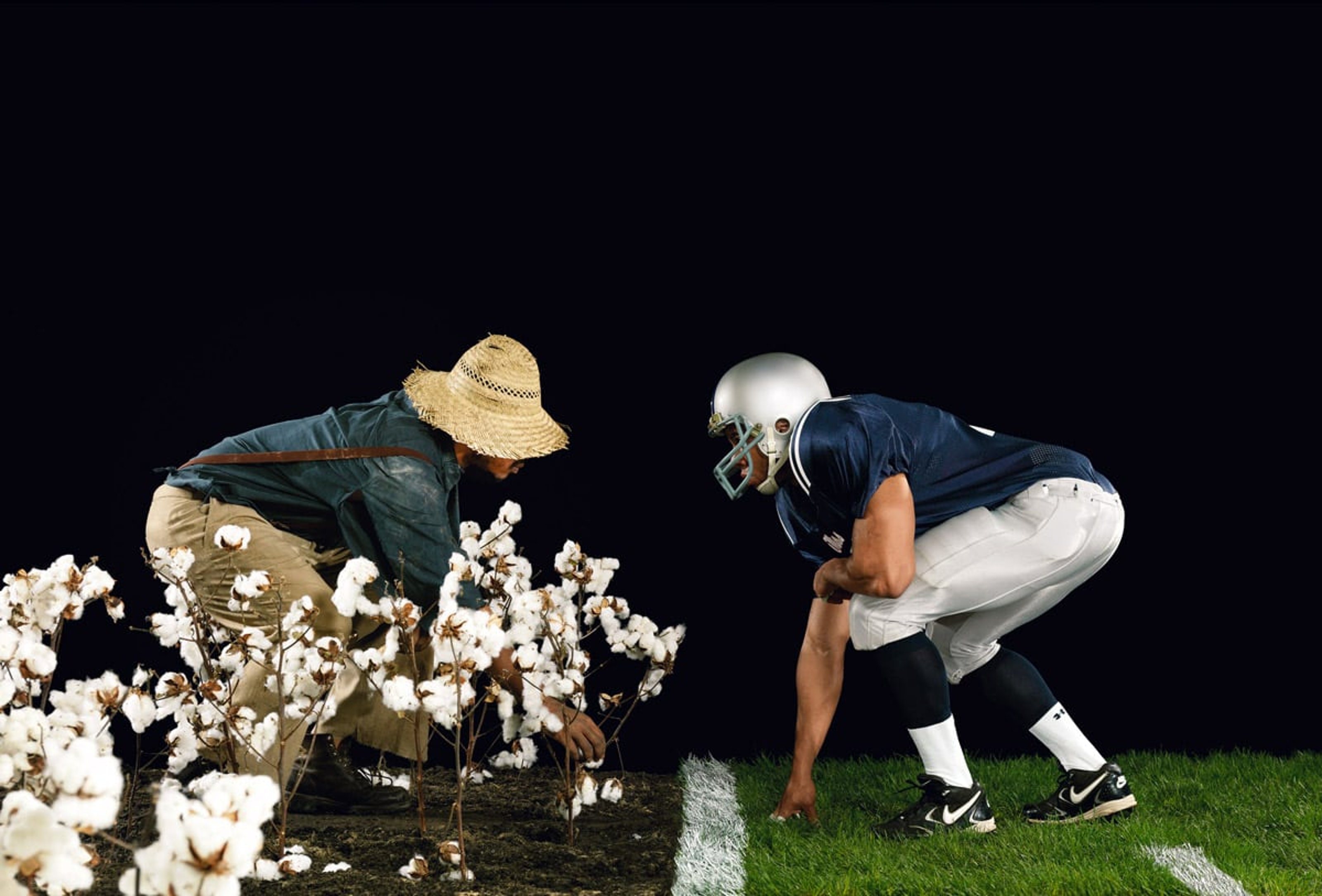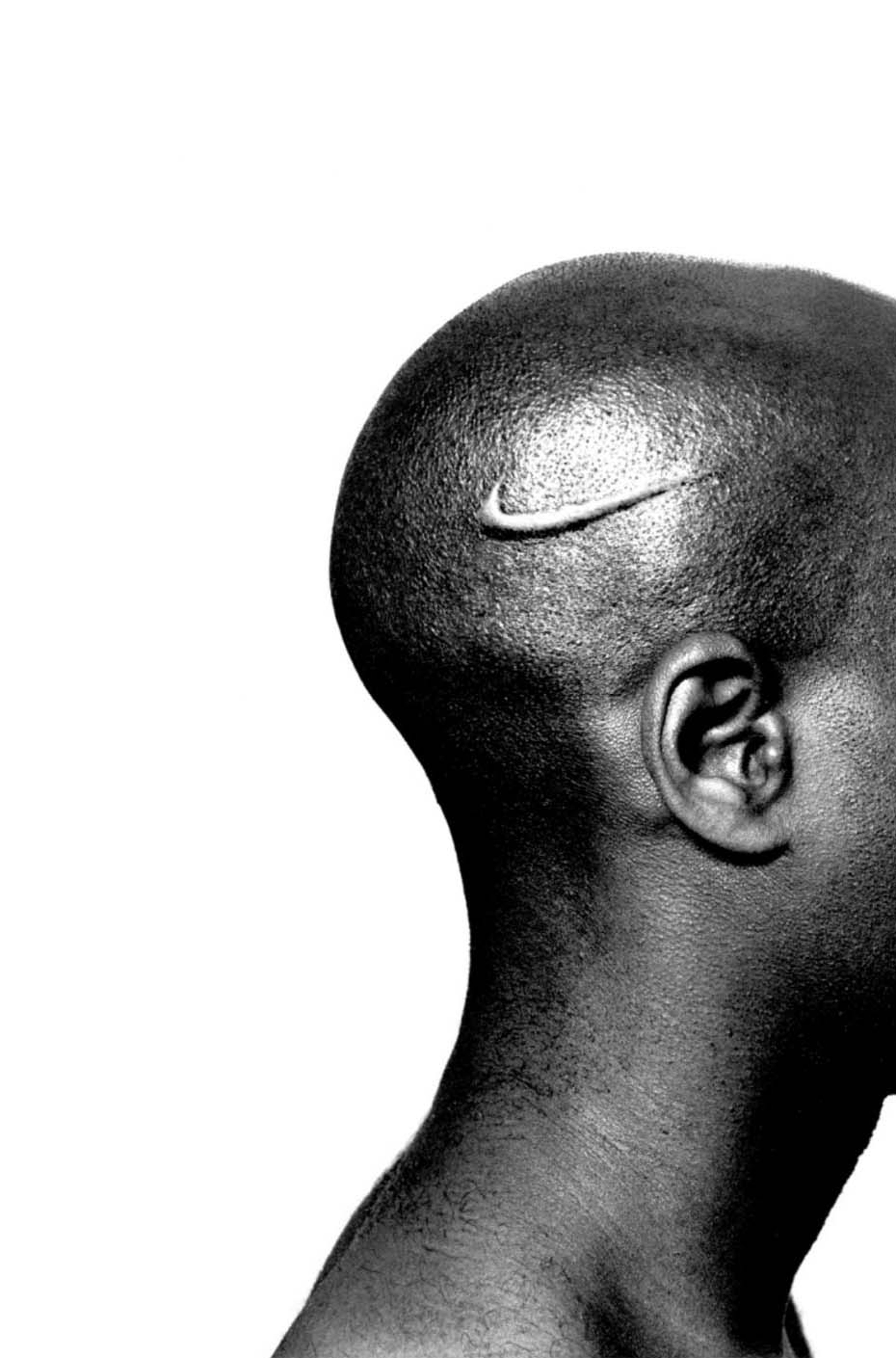
Hank Willis Thomas/ Basketball and Chain, 2003. Digital C-print. Image credit to Hank Willis Thomas and Jack Shainman Gallery, New York.
Hank Willis Thomas is an American conceptual artist who addresses critical issues like racism, violence, and consumerism through a range of visually strategic artworks. He critically examines media and popular culture, grounds his photographs and sculptures in US political history, and challenges the viewers to confront the legacy of institutional racism while reflecting on their identity as consumers. He is also a co-founder of the artist-led activist organization, For Freedoms, which aims to reshape conversations on politics through artists’ creative interventions.
Entering high school in the early 1990s, Hank Willis Thomas witnessed the rapid bloom of US corporate brands on the back of stardom and marketing. Michael Jordan had just signed a contract with Nike in 1984 when the US brand agreed to establish his sneaker line. In no time, streetwear brands had taken popular culture by storm, and the sneakers had become a cult item. Willis Thomas recounts that by then people were getting killed for Air Jordan sneakers. Accordingly, compared to the revenue in 1983, Nike’s revenue doubled in 1990 and had an eightfold increase in 1996.
Upon recognizing the largely unignorable role Michael Jordan and his career has played in the branding of Nike, the NBA, and Gatorade, Hank Willis Thomas, as an African American teenager immersed in popular culture, wondered why there wasn’t much acknowledgment of the fact that Michael Jordan was an African-American. But in addition to this, he also had the revelation that “the elusive ideas that brands represent can actually become central to one’s personality.” This idea stayed with him especially when corporate brands’ influential campaigns like Apple’s “think different” campaign continued to shape a generation of young Americans.
Going on to his graduate studies at California College of Arts; Willis Thomas, inspired by books like The Society of the Spectacle by Guy Debord, built a theoretical backup for his continuing investigation of corporate branding and within it, the role of African-American male bodies. Although the concept of the spectacle, the autocratic reign of the market economy, has been generally seen as an all-encompassing and often unhealthy aspect of our modern consumer culture, it is also hard to ignore that spectacles like sports and entertainment have magically captivated the minds of people all over the world, across language and cultural barriers. Like what Thomas said, “sports like basketball, like track and field, have been able to transcend things that wars, books, and even artworks have not been able to transcend.” The power of these spectacles much deserves examination.

Hank Willis Thomas/ The Cotton Bowl, from the series Strange Fruit, 2011. Digital c-print. 50 x 73 inches. Image credit to Hank Willis Thomas and Jack Shainman Gallery, New York.
In Hank Willis Thomas’ works, the spectacle of sports and the status of African Americans are ambiguous issues. On one hand, the branding of black bodies in our consumer culture recalled the branding of black bodies in slavery in the U.S. history and the prolonged problem of cultural and racial exploitation; on the other hand, sports became the place where “these descendants of slaves, sharecroppers, and descendants of immigrants overcame all of these perceivable obstacles to be seen as magical and beautiful, to be seen as powerful and even seen as dominant.” In his B(r)anded Series, Hank Willis Thomas explores this tension in the representation of the African-American male body in visual culture and how these seemingly free-market-driven actions are indeed political. Similarly, in his work The Cotton Bowl, from the series Strange Fruit in 2011, the juxtaposition of football and cotton picking, one of the most important aspects of American sports culture and the dark history of black enslavement, pushes the viewer to examine the pervasiveness of black violence in our popular culture. His works call for a political consciousness as well as a pair of observant and discerning eyes in consumers of spectacles — that is every one of us.

Hank Willis Thomas_/ Branded Head_, 2003, from the series Branded. Chromogenic print. Image credit to Hank Willis Thomas and Jack Shainman Gallery, New York.
In his course, Hank Willis Thomas points out that in 2020—after the murder of George Floyd at the hands of a police officer and the months of unrest that followed—the spectacle of sports and entertainment had stopped for the first time in anyone’s memory. Sporting events and concerts had been canceled. “And with all of that absence, I think the awareness of a black man being crushed to death, that spectacle became so much greater.” For Freedoms, an artist-led organization co-founded by Hank Willis Thomas, was an active source of activist action in the aftermath of this event. Their billboard campaign aptly relied on the power of advertisement and continuously tried to stir up political debates by presenting ironic juxtapositions of current and historical political references– like when “make America great again” was superimposed over an image of an epic march from Selma to Montgomery, Alabama, in 1965 for equal voting rights.

Artwork: For Freedoms/ “Make America Great Again”, a billboard is installed in Pearl, Mississippi in 2016. Image credit to Wyatt Gallery.
Through his works, Hank Willis Thomas reminds us of the historical struggle of racial minorities in US history and the systematic oppression embedded in the way we consume culture, entertainment, and interpret artworks. He uses rather approachable visual languages like that of advertisement to make alarming connections between contemporary culture and historical events. Thomas thinks that on top of object history, political history should also be understood as an important component of art history and art-making. How might this strategy affect the way you engage with artworks around you?

In the course “All Action is Political ” taught by Hank Willis Thomas, you can learn more about how art can effectively engage with political history and function as a means for political activism. Hank Willis Thomas will also teach his research on African heritage and what led him to believe that “what we call modern and contemporary art is really a misinterpretation of contemporary African thought 120 years ago;” Enroll now, available on Collecteurs Academy Library Access. Watch anytime on your own schedule.